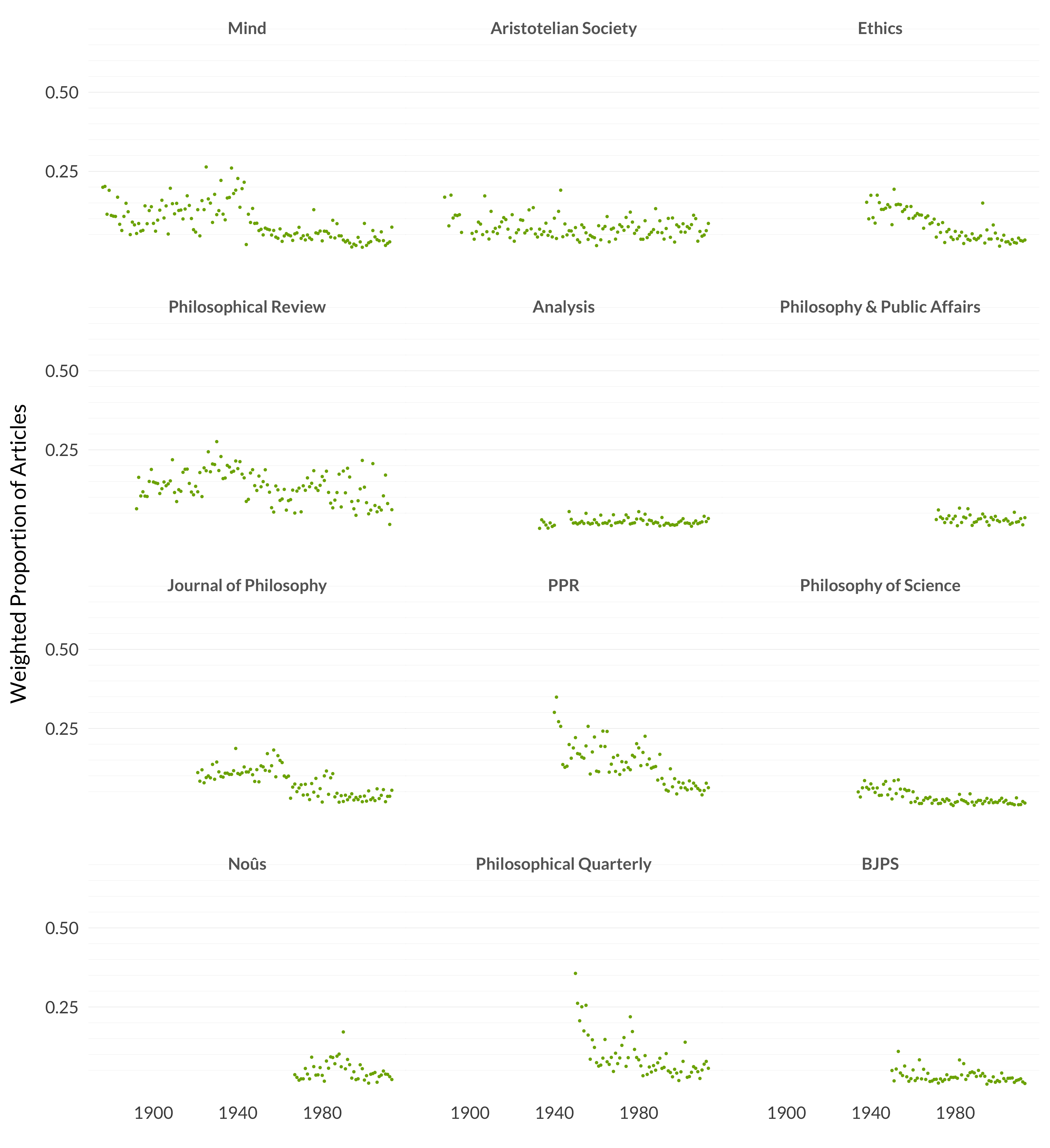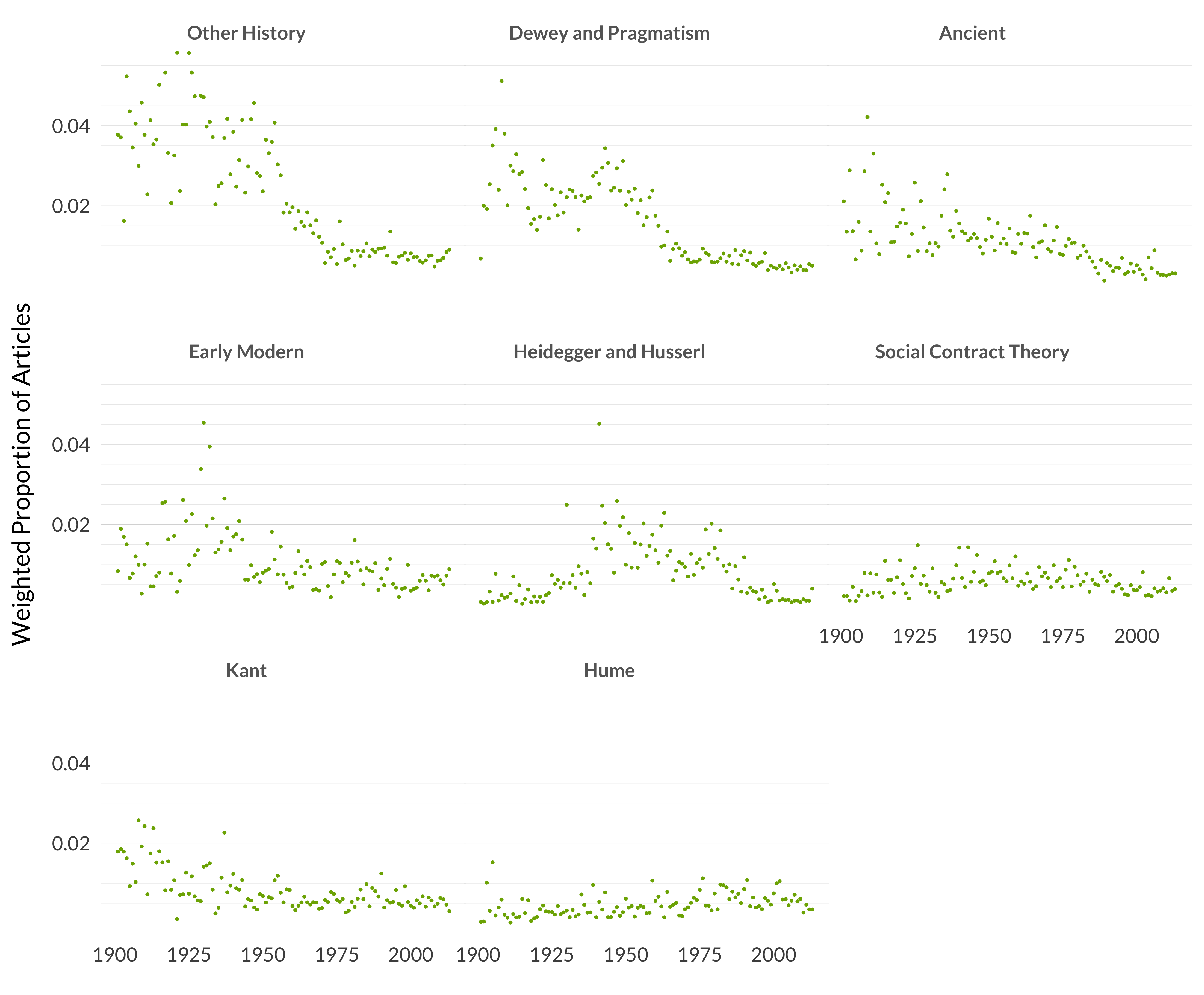4.4 History

Figure 4.10: Proportion of each journal’s yearly publications in history of philosophy.
None of these lines seem to be trending up, and several of them are trending down. But there are differences in the ways that they are trending.
- Ethics is a slow, steady decline.
- Journal of Philosophy is a very rapid decline over the 1960s, between a high equilibrium before that, and a much lower equilibrium after.
- Mind falls off a cliff around World War II, around the same time Ryle takes over.
- Philosophy and Phenomenological Research falls away around 1990, as they stop taking quite as seriously the part of their name that says “phenomenological”. (I don’t know how closely this tracks with Ernest Sosa becoming editor of PPR.)
So part of what’s going on is what I mentioned in the previous section. Specialist journals are focusing more on their specialty, and this means doing less of everything else. And in part this feels like the long influence of Gilbert Ryle. This might seem odd given that Ryle published in history of philosophy, including several papers on early modern and on phenomenology, but there is some independent evidence of this. This is from an article his successor as Mind editor, D. M. Hamlyn, wrote about Ryle’s editorship.
[Ryle] said, for example, that, except for Greek Philosophy, he tended to not accept papers on the history of philosophy, and he also said something about what was normally the desirable maximum length for papers. I must say that I found what he had to say on the first point rather odd, though he was absolutely right on the second. (Hamlyn 2003, 5–12)
Whatever Hamlyn thought, it doesn’t seem to have affected the publications much. You can’t see his ascension (in 1971) in the data here. And I think this decision of Ryle’s (or of the board of Mind at the time Ryle was appointed) had a large impact on the role of journal articles in history of philosophy. (Though note Hamlyn says in that paper that Ryle left him a backlog of 2 years’ material to publish. So any break would be 1973 not 1971. Both these facts, that Mind was only publishing its backlog in 1972 and 1973, and that they were still papers accepted by Ryle, are quite interesting in the context of the differences in citation rates between Mind and its US counterparts in those years. But that’s a story for another study.)

Figure 4.11: Topics in history of philosophy.
| Subject | Year | Frequency |
|---|---|---|
| Other history | 1916 | 0.0729 |
| Other history | 1928 | 0.0698 |
Two things jump out here.
One is that when history of philosophy was a major part of the journals, it was driven by the weird mix from other history, not the big names. Remember that the paradigm article from Topic 4 was about James Marsh.
The other is that Dewey and pragmatism is also a big part of the story, at least when history is prominent in the journals.
But note that both of these things suggest that to some extent the strength of history before World War II is a touch overstated. Other History includes a bunch of papers that are, if history, very much the first draft of history. For example, for several decades Philosophical Review published an annual piece on philosophy in France, usually written by André Lalande. (A bunch of these papers can be accessed via PhilPapers, but I haven’t looked at many of them personally.) It’s kind of history—it surveys what has happened in a place in a historical period. It’s just that the period was, you know, the year that just passed. So not really that historical. All of these articles are classed as history by the algorithm. That doesn’t explain what happened with Mind, of course, but there is stuff there that is only history for want of somewhere else to put it.
And while many of the pragmatism papers are genuinely history papers—they are about works by Dewey several decades after those works were written—some of them are simply works of pragmatist philosophy. (And of course Dewey is still alive, and even publishing, into the 1940s. I think it’s possible to do historical work on a figure while they are still alive, but it’s a bit odd.)
So I don’t think we should think there was really a golden age for publishing history of philosophy in these journals that has now ceased. They did publish things that were historical. And papers on Marsh or on Geulincx are really a kind of history that we just don’t see in the current journals. Maybe we need to bring back that kind of history of philosophy. (As I’ll discuss at the end of the book, there is some evidence that we are bringing that kind of history back.)